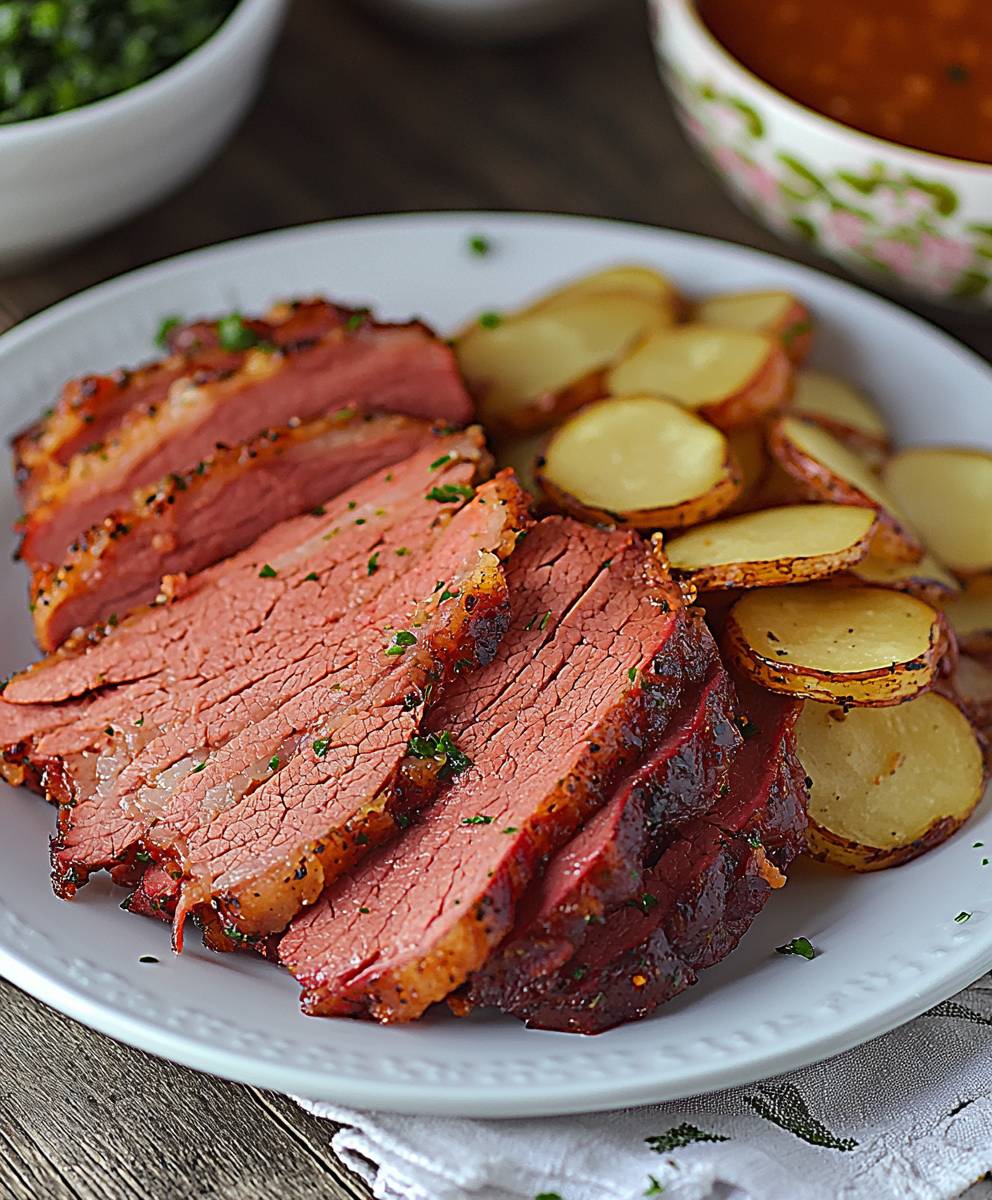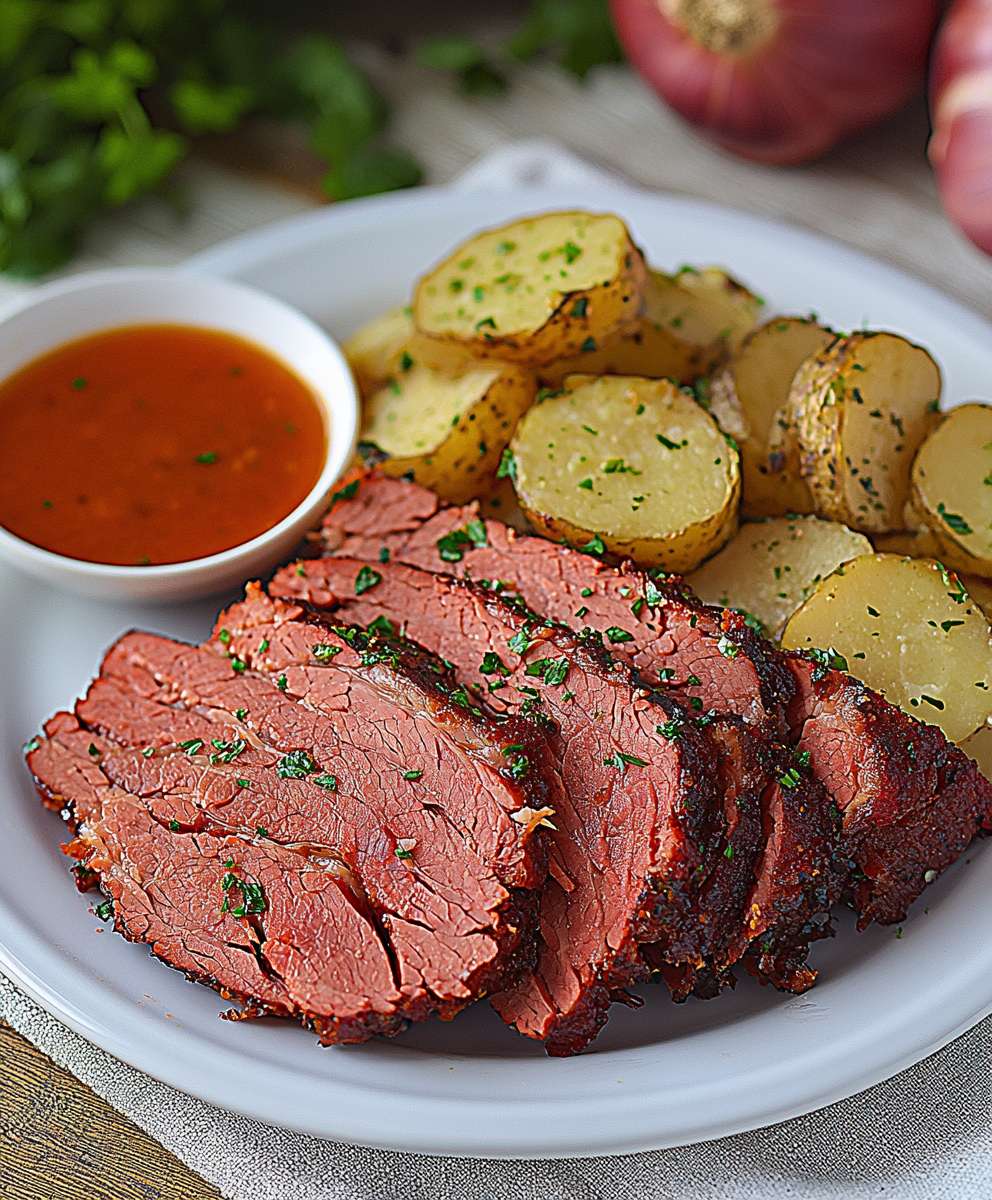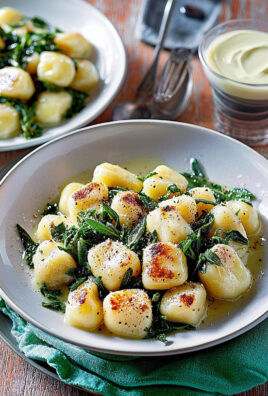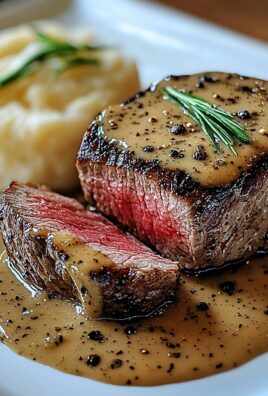Corned Beef Homemade the very words conjure up images of hearty meals, family gatherings, and that unmistakable, savory aroma filling the kitchen. Have you ever wondered if you could recreate that deli-style deliciousness right in your own home? I’m here to tell you, you absolutely can! Forget relying on store-bought versions; with a little patience and this foolproof recipe, you’ll be serving up the most tender, flavorful corned beef you’ve ever tasted.
Corned beef boasts a rich history, deeply intertwined with Irish-American culture. While often associated with St. Patrick’s Day, its roots trace back to a time when preserving beef with salt was a necessity. The term “corned” refers to the large grains of salt, or “corns,” used in the curing process. Over time, it became a staple, particularly among Irish immigrants in America, who found it a more affordable alternative to traditional bacon.
But what is it about Corned Beef Homemade that makes it so irresistible? It’s the perfect combination of salty, savory, and slightly tangy flavors, coupled with a melt-in-your-mouth texture that’s simply divine. Whether you’re serving it sliced thin on rye bread with mustard, or as the centerpiece of a traditional boiled dinner with cabbage and potatoes, this dish is guaranteed to be a crowd-pleaser. Plus, making it yourself allows you to control the ingredients and customize the flavor to your liking. So, let’s get started and unlock the secrets to perfect homemade corned beef!

Ingredients:
- 4-5 lb Corned Beef Brisket: Look for a well-marbled brisket with a good layer of fat. This will ensure a tender and flavorful final product.
- 1 tbsp Pickling Spice: You can buy pre-made pickling spice or make your own blend. Common ingredients include coriander seeds, mustard seeds, black peppercorns, allspice berries, bay leaves, cloves, and sometimes dried chilies.
- 1 large Onion: Quartered. Yellow or white onions work best.
- 4-5 Carrots: Peeled and cut into 2-inch pieces.
- 4-5 Celery Stalks: Cut into 2-inch pieces.
- 6-8 Cloves Garlic: Peeled and smashed.
- 8 cups Beef Broth: Low sodium is preferred, so you can control the salt level.
- 4 cups Water: Adjust as needed to ensure the brisket is submerged.
- 1 tbsp Brown Sugar: Optional, but adds a touch of sweetness that balances the saltiness.
- 1 tsp Black Peppercorns: Whole peppercorns, in addition to the pickling spice, enhance the peppery flavor.
- 2 Bay Leaves: Adds a subtle, aromatic flavor.
- Optional Vegetables for Serving: Potatoes, cabbage, turnips, parsnips.
Preparing the Corned Beef:
- Rinse the Brisket: Remove the corned beef brisket from its packaging and rinse it thoroughly under cold water. This helps to remove excess salt from the curing process. Pat it dry with paper towels.
- Desalting (Optional but Recommended): If you’re sensitive to salt, you can desalinate the brisket further. Place the brisket in a large pot and cover it with cold water. Bring to a boil, then drain the water. Repeat this process 2-3 times. This will draw out a significant amount of salt. However, be mindful that you’ll also be removing some of the flavor, so adjust the cooking time and seasonings accordingly. I usually skip this step, but it’s good to know it’s an option.
Cooking the Corned Beef:
- Combine Ingredients in a Large Pot or Dutch Oven: Place the rinsed (and optionally desalted) corned beef brisket in a large pot or Dutch oven. Add the quartered onion, carrots, celery, smashed garlic, pickling spice, beef broth, water, brown sugar (if using), black peppercorns, and bay leaves. Make sure the brisket is completely submerged in the liquid. If not, add more water or beef broth as needed.
- Bring to a Boil, Then Simmer: Bring the mixture to a boil over high heat. Once boiling, reduce the heat to low, cover the pot tightly, and simmer gently for 3-4 hours, or until the brisket is fork-tender. The exact cooking time will depend on the size and thickness of the brisket. Check for doneness by inserting a fork into the thickest part of the brisket. It should slide in easily with minimal resistance.
- Slow Cooker Option: Alternatively, you can cook the corned beef in a slow cooker. Place all the ingredients in the slow cooker, ensuring the brisket is submerged. Cook on low for 8-10 hours, or on high for 4-5 hours, or until the brisket is fork-tender.
- Instant Pot Option: For a faster cooking method, use an Instant Pot. Place the brisket and all the ingredients in the Instant Pot. Add enough liquid to cover the brisket. Secure the lid and cook on high pressure for 75-90 minutes, followed by a natural pressure release for 15-20 minutes. Then, manually release any remaining pressure.
Adding the Vegetables (Optional):
- Prepare the Vegetables: About 1 hour before the corned beef is done, prepare your vegetables. Peel and cut potatoes into large chunks. Cut cabbage into wedges. Peel and cut turnips and parsnips into similar-sized pieces.
- Add Vegetables to the Pot: Add the potatoes, carrots, turnips, and parsnips to the pot with the corned beef. Make sure the vegetables are mostly submerged in the liquid. If not, add a little more water.
- Add Cabbage Later: Add the cabbage wedges about 30 minutes before the corned beef is done. Cabbage cooks quickly and can become mushy if overcooked.
- Continue Simmering: Continue simmering the corned beef and vegetables until the vegetables are tender.
Slicing and Serving:
- Remove the Brisket: Once the corned beef is cooked through and fork-tender, carefully remove it from the pot and place it on a cutting board. Let it rest for at least 10-15 minutes before slicing. This allows the juices to redistribute, resulting in a more tender and flavorful brisket.
- Slice Against the Grain: Identify the grain of the meat (the direction of the muscle fibers). Using a sharp knife, slice the corned beef thinly against the grain. This is crucial for tenderness. If you slice with the grain, the meat will be tough and chewy.
- Serve: Arrange the sliced corned beef on a platter with the cooked vegetables. Ladle some of the cooking liquid over the meat and vegetables to keep them moist.
- Serving Suggestions: Serve the corned beef and cabbage with horseradish sauce, mustard, or a simple parsley sauce. Some people also enjoy it with Irish soda bread or rye bread.
Tips for the Best Corned Beef:
- Don’t Overcook: Overcooked corned beef can become dry and stringy. Cook it until it’s fork-tender, but not falling apart.
- Use a Meat Thermometer: For precise cooking, use a meat thermometer. The internal temperature of the corned beef should reach 190-205°F (88-96°C).
- Let it Rest: Resting the corned beef before slicing is essential for tenderness.
- Slice Against the Grain: This is the most important tip for tender corned beef.
- Adjust Seasoning: Taste the cooking liquid and adjust the seasoning as needed. You may want to add more salt, pepper, or other spices to your liking.
- Save the Cooking Liquid: The cooking liquid is full of flavor and can be used to make a delicious soup or stew. Strain the liquid and store it in the refrigerator for up to 3 days.
- Leftover Corned Beef: Leftover corned beef can be stored in the refrigerator for up to 3 days. It can be used in sandwiches, hash, or other dishes.
- Pickling Spice Variations: Feel free to adjust the pickling spice blend to your liking. You can add more or less of certain spices, or add other spices such as juniper berries or star anise.
- Fat Cap: Some people prefer to trim the fat cap on the corned beef before cooking, while others prefer to leave it on for added flavor and moisture. It’s a matter of personal preference. I usually leave it on, but trim it after cooking if it’s excessive.
- Salt Content: Corned beef is naturally salty due to the curing process. If you’re concerned about the salt content, you can desalinate the brisket as described above. You can also use low-sodium beef broth and avoid adding extra salt to the cooking liquid.
Troubleshooting:
- Corned Beef is Too Salty: If the corned beef is too salty, try desalting it before cooking. You can also add a potato to the pot while cooking, as it will absorb some of the salt.
- Corned Beef is Tough: If the corned beef is tough, it may be undercooked or sliced with the grain. Cook it longer until it’s fork-tender, and make sure to slice it against the grain.
- Vegetables are Mushy: If the vegetables are mushy, you may have overcooked them. Add them to the pot later in the cooking process, and check them frequently for doneness.
- Corned Beef is Dry: If the corned beef is dry, it may be overcooked. Cook it until it’s fork-tender, but not falling apart. You can also add more liquid to the pot during cooking.

Conclusion:
So, there you have it! This homemade corned beef recipe isn’t just another meal; it’s a journey back to tradition, a celebration of flavor, and a testament to the magic that happens when you slow down and create something truly special. I know, I know, making your own corned beef might seem intimidating at first, but trust me, the incredible depth of flavor you achieve simply blows the store-bought stuff out of the water. The tender, melt-in-your-mouth texture and the perfectly balanced blend of spices will have you wondering why you didn’t try this sooner. It’s a labor of love, absolutely, but the reward is a culinary experience unlike any other. Why is this recipe a must-try? Because it’s about more than just corned beef. It’s about reclaiming control over your ingredients, knowing exactly what goes into your food, and experiencing the satisfaction of creating something truly authentic. It’s about sharing a meal with loved ones that’s steeped in history and bursting with flavor. And let’s be honest, the bragging rights are pretty great too! Imagine telling your friends you made your own corned beef from scratch! Now, let’s talk serving suggestions. Of course, the classic way to enjoy this incredible homemade corned beef is in a traditional boiled dinner with cabbage, potatoes, and carrots. The sweetness of the carrots and the earthiness of the potatoes perfectly complement the savory, spiced flavor of the beef. But don’t stop there! Get creative! Slice it thinly and pile it high on rye bread with Swiss cheese, sauerkraut, and Russian dressing for an unforgettable Reuben sandwich. Or, dice it up and add it to a hearty hash with fried eggs for a delicious breakfast or brunch. You could even use it as a filling for savory hand pies or empanadas. The possibilities are endless! And speaking of variations, feel free to experiment with the spice blend to suit your own taste. If you like a little heat, add a pinch of red pepper flakes to the brine. If you prefer a sweeter flavor, add a tablespoon of brown sugar. You can also adjust the cooking time to achieve your desired level of tenderness. Some people prefer their corned beef to be fall-apart tender, while others like it to have a bit more bite. The beauty of making it yourself is that you can customize it to your exact preferences.Serving Suggestions and Variations:
- Classic Boiled Dinner: Serve with cabbage, potatoes, and carrots.
- Reuben Sandwich: Thinly sliced on rye bread with Swiss cheese, sauerkraut, and Russian dressing.
- Corned Beef Hash: Diced and added to a hash with fried eggs.
- Savory Pies: Use as a filling for hand pies or empanadas.
- Spice Variations: Add red pepper flakes for heat or brown sugar for sweetness.

Corned Beef Homemade: The Ultimate Guide to Making It Yourself
- Total Time: 3 hours 10 minutes
- Yield: 6–8 servings 1x
Description
Homemade corned beef, brined for days with spices, then slow-cooked to tender perfection. A flavorful and rewarding project.
Ingredients
- 3 pounds beef brisket, about 1 1/2 inches thick
- 1 gallon water
- 1 cup kosher salt
- 1/2 cup brown sugar
- 2 tablespoons pink curing salt (also called Prague powder #1)
- 1 tablespoon black peppercorns
- 1 tablespoon coriander seeds
- 1 tablespoon mustard seeds
- 1 teaspoon red pepper flakes
- 6 cloves garlic, crushed
- 2 bay leaves
- 1 cinnamon stick
- 8 whole cloves
- 1 teaspoon ground ginger
Instructions
- Place brisket in a large pot or Dutch oven and cover with water.
- Add pickling spices, bay leaf, and garlic.
- Bring to a boil, then reduce heat and simmer for 3-4 hours, or until brisket is tender.
- Remove brisket from pot and let rest for 15 minutes.
- Slice against the grain and serve.
Notes
“`html
- Note: This recipe requires 5-7 days of curing time.
- Note: Pink curing salt is essential for the curing process and should not be omitted.
- Note: Ensure the brisket is fully submerged in the brine during curing.
- Note: Adjust spice amounts to your preference.
- Note: Cooking time may vary depending on the size and thickness of the brisket. Use a meat thermometer to ensure it reaches an internal temperature of 203°F (95°C) for optimal tenderness.
“`
- Prep Time: 20 minutes
- Cook Time: 3 hours




Leave a Comment